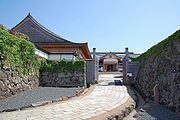
Sasayama Domain
Encyclopedia

Han (Japan)
The or domain was the name of the estate belonging to a warrior in Japan after the 17th century. The fiefs of the daimyos of the samurai class of Japan during the Edo period were called han.-Edo period:...
of the Edo period
Edo period
The , or , is a division of Japanese history which was ruled by the shoguns of the Tokugawa family, running from 1603 to 1868. The political entity of this period was the Tokugawa shogunate....
, located in Tanba Province. It was founded in 1609, when Matsudaira Yasushige
Matsudaira Yasushige
was a Japanese samurai of the Azuchi-Momoyama through early Edo periods. He was the family head of the Matsui-Matsudaira, a family which received the Matsudaira name as an honorific following his father's service to Tokugawa Ieyasu. Yasushige ended his life as daimyo of Kishiwada han.-References:*...
moved there from the Yakami Domain
Yakami Domain
' was a Japanese domain of the Edo period, located in Tanba Province . It was ruled by Maeda Shigekatsu and then by Matsudaira Yasushige, the head of the Matsui-Matsudaira clan. The domain was abolished in 1609....
. The domain changed hands several times until 1748, when it was given to Aoyama Tadatomo. The Aoyama family remained there until 1868; the domain itself was abolished in 1871. Its territory first became part of the short-lived Toyooka Prefecture, before being made part of Hyogo Prefecture in 1876; it remains part of Hyogo Prefecture to the present day.
The Aoyama, the last ruling family, became viscounts in the Meiji era.
List of lords
- Matsudaira (Matsui) clanMatsudaira clanThe was a Japanese samurai clan that claimed descent from the Minamoto clan. It first originated in and took its name from Matsudaira village, in Mikawa Province . Over the course of its history, the clan produced many branches, most of which also centered around Mikawa Province...
(FudaiFudaiwas a class of daimyo who were hereditary vassals of the Tokugawa in Edo period Japan. It was primarily the fudai who filled the ranks of the Tokugawa administration.-Origins:...
; 50,000 kokuKokuThe is a Japanese unit of volume, equal to ten cubic shaku. In this definition, 3.5937 koku equal one cubic metre, i.e. 1 koku is approximately 278.3 litres. The koku was originally defined as a quantity of rice, historically defined as enough rice to feed one person for one year...
)
- YasushigeMatsudaira Yasushigewas a Japanese samurai of the Azuchi-Momoyama through early Edo periods. He was the family head of the Matsui-Matsudaira, a family which received the Matsudaira name as an honorific following his father's service to Tokugawa Ieyasu. Yasushige ended his life as daimyo of Kishiwada han.-References:*...
- Matsudaira (Fujii) clanMatsudaira clanThe was a Japanese samurai clan that claimed descent from the Minamoto clan. It first originated in and took its name from Matsudaira village, in Mikawa Province . Over the course of its history, the clan produced many branches, most of which also centered around Mikawa Province...
(FudaiFudaiwas a class of daimyo who were hereditary vassals of the Tokugawa in Edo period Japan. It was primarily the fudai who filled the ranks of the Tokugawa administration.-Origins:...
; 50,000 kokuKokuThe is a Japanese unit of volume, equal to ten cubic shaku. In this definition, 3.5937 koku equal one cubic metre, i.e. 1 koku is approximately 278.3 litres. The koku was originally defined as a quantity of rice, historically defined as enough rice to feed one person for one year...
)
- Nobuyoshi
- Tadakuni
- Matsudaira (Katanohara) clanMatsudaira clanThe was a Japanese samurai clan that claimed descent from the Minamoto clan. It first originated in and took its name from Matsudaira village, in Mikawa Province . Over the course of its history, the clan produced many branches, most of which also centered around Mikawa Province...
(FudaiFudaiwas a class of daimyo who were hereditary vassals of the Tokugawa in Edo period Japan. It was primarily the fudai who filled the ranks of the Tokugawa administration.-Origins:...
; 50,000 kokuKokuThe is a Japanese unit of volume, equal to ten cubic shaku. In this definition, 3.5937 koku equal one cubic metre, i.e. 1 koku is approximately 278.3 litres. The koku was originally defined as a quantity of rice, historically defined as enough rice to feed one person for one year...
)
- Yasunobu
- Sukenobu
- Nobutoshi
- Nobutsune
- Nobumine
- Aoyama clanAoyama clanThe ' was a Japanese clan which came to prominence during the Sengoku period. Its origins were in Kōzuke Province; however, members of the family moved to Mikawa Province and served the Matsudaira clan...
(FudaiFudaiwas a class of daimyo who were hereditary vassals of the Tokugawa in Edo period Japan. It was primarily the fudai who filled the ranks of the Tokugawa administration.-Origins:...
; 50,000->60,000 kokuKokuThe is a Japanese unit of volume, equal to ten cubic shaku. In this definition, 3.5937 koku equal one cubic metre, i.e. 1 koku is approximately 278.3 litres. The koku was originally defined as a quantity of rice, historically defined as enough rice to feed one person for one year...
)
- Tadatomo
- Tadataka
- Tadatsugu
- Tadayasu
- Tadanaga
- Tadayuki

